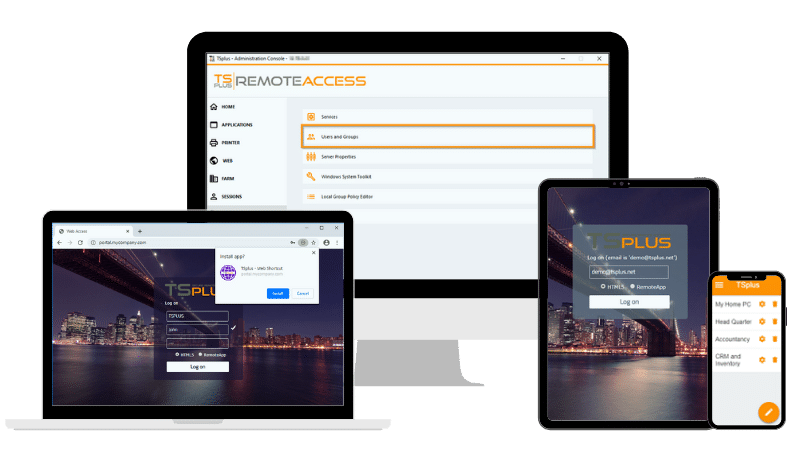)
)
TSplus is a secure and cost-effective alternative to Windows Remote Desktop Services (RDS), allowing you to enable remote access to a Windows 10 system in just a few minutes. Whether you are supporting a distributed workforce or simply want to access your desktop from home, this guide explains how to use TSplus and be up and running quickly.
Why Use TSplus Instead of Windows RDS?
Windows 10 includes built-in Remote Desktop features, but they can be limited depending on your version of Windows. RDS on Windows Server adds more capabilities but comes with high costs, licensing complexities and advanced configuration requirements. The worst is these often exceed the needs of small and medium-sized businesses.
TSplus offers a simpler solution. It is designed to provide secure, remote access to applications and desktops on any Windows system (including Windows 10 Pro) without needing a full Windows Server infrastructure. The advantages of TSplus include:
- Quick installation and easy setup
- Cross-platform access using any browser or device
- HTML5 web portal for clientless connectivity
- Affordable licensing with no CALs required
- Active compatibility updates for every Windows version
These benefits make TSplus ideal for businesses that want enterprise-grade remote access without the enterprise-level costs and complexity.
What Are the System Requirements and Preparations?
Before installing TSplus, it's important to ensure your system meets the basic requirements for optimal performance and security. TSplus is compatible with a wide range of Windows operating systems, including:
- Windows 7 SP1
- Windows 8.1
- Windows 10 Pro, Enterprise and Education
- Windows 11
- Windows Server editions (2008 R2 to 2022)
For TSplus to run smoothly on a Windows 10 machine, you should have at least:
- A 2 GHz processor (quad-core recommended for multiple users)
- 4 GB RAM (8 GB or more for multiple sessions)
- A stable network connection
- Administrator rights for installation
TSplus installs directly on your local Windows 10 system and turns it into a multi-user remote access server. You need no additional hardware or cloud hosting services unless you plan to scale widely.
How to Install and Set Up TSplus on Windows 10?
Getting started with TSplus is straightforward. Follow these steps to install and configure the platform:
- Download and Install.
- Add Users and Set Permissions.
- Configure Network Access.
Download and Install
To start with, download the latest version of TSplus from the official TSplus website. Once downloaded:
- Run the installer as an administrator.
- Accept the license agreement.
- Follow the guided installation wizard.
Within minutes, TSplus will install core services and make basic configurations automatically.
Add Users and Set Permissions
After installation, open the TSplus Admin Tool, a centralized dashboard for managing your remote desktop environment. From here, you can:
- Add new user accounts or sync with existing Windows users.
- Set access permissions (e.g., full desktop or application-only mode).
- Choose session types and timeouts.
TSplus supports multiple concurrent sessions on a single machine, making it ideal for teams that need to access the same resources remotely.
Configure Network Access
For external access, you will need to configure your firewall and router:
- Default RDP Port: TSplus uses port 3389 by default but allows customization for added security.
- Firewall Rules: Ensure inbound traffic is allowed for your selected port and that appropriate security measures are in place.
- Port Forwarding: Set up your router to forward the port to the TSplus host machine.
Advanced users may also configure static IP addresses or use Dynamic DNS (DDNS) services to make access easier.
What Are the Different Connection Methods?
TSplus offers several ways to connect to a Windows 10 environment remotely:
- TSplus HTML5 Web Access
- TSplus Remote Desktop Client
- TSplus Connection Client Generator
TSplus HTML5 Web Access
This is the most flexible option. Users can log in from any browser without needing to install software. Simply enter the server’s IP address or domain name followed by the web portal path.
For example: https://yourdomain.com:port
The interface supports drag-and-drop file transfers, copy-paste between local and remote environments and responsive layouts for tablets and smartphones.
TSplus Remote Desktop Client
The native client provides a traditional RDP experience, optimized for TSplus environments. It supports full-screen mode, local device redirection and performance tuning for low-bandwidth connections.
TSplus Connection Client Generator
With the Admin Tool, you can create pre-configured .exe clients for your users. These clients launch directly into a session, requiring no manual input, which is perfect for non-technical end users.
The TSplus system also supports connections from macOS, Linux, iOS, and Android, ensuring full cross-platform compatibility.
How to Keep Compatibility with Windows 10 Updates?
One of the challenges of using Remote Desktop on Windows 10 is keeping up with Microsoft’s frequent updates. Patch Tuesday can sometimes disrupt remote access features, especially with changes to network security or RDP protocol behavior.
TSplus addresses this proactively by:
- Issuing weekly updates to remain compatible with the latest Windows builds
- Offering Long-Term Support (LTS) versions for businesses that prioritize stability over new features
- Deploying silent background updates, ensuring minimal disruption
For example, after Microsoft released major Windows 10 updates in November and December 2020, TSplus quickly pushed kernel updates to ensure continued compatibility. These are automatically applied to servers connected to the internet, requiring no user intervention.
This level of responsiveness reduces IT headaches and ensures your business operations remain uninterrupted, even during major Windows rollouts. You can follow the latest release notes and patch details on the TSplus changelog page.
What is Admin Tool?
One of the standout features of TSplus is its Admin Tool, a powerful yet intuitive interface that consolidates all system management in one place. IT administrators can do the following:
- Assign user access policies.
- Publish specific applications for remote use.
- Configure the web portal appearance and branding.
- Set up two-factor authentication.
- Manage SSL certificates and encryption protocols.
These capabilities are especially useful for companies with strict security or compliance requirements. With AdminTool, administrators can lock down environments to minimize risk while providing flexible access to authorized users.
Conclusion on how to Use TSplus for Remote Desktop Access
TSplus makes Remote Desktop access on Windows 10 easier, more flexible and more secure. It removes the need for costly infrastructure and simplifies remote work setup for businesses of any size. With just a few clicks, your team can connect to applications, desktops or servers from anywhere in the world.
Whether you support a hybrid work environment, host legacy software or enable secure access for contractors, TSplus offers an affordable and scalable solution.
To learn more about how TSplus can transform your remote access strategy, visit the TSplus Remote Access product page or explore additional tools on the TSplus blog.

TSplus Remote Access Free Trial
Ultimate Citrix/RDS alternative for desktop/app access. Secure, cost-effective, on-premises/cloud














)
)
)